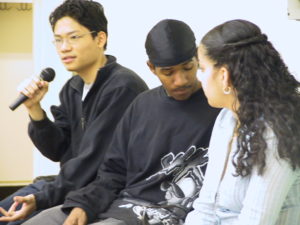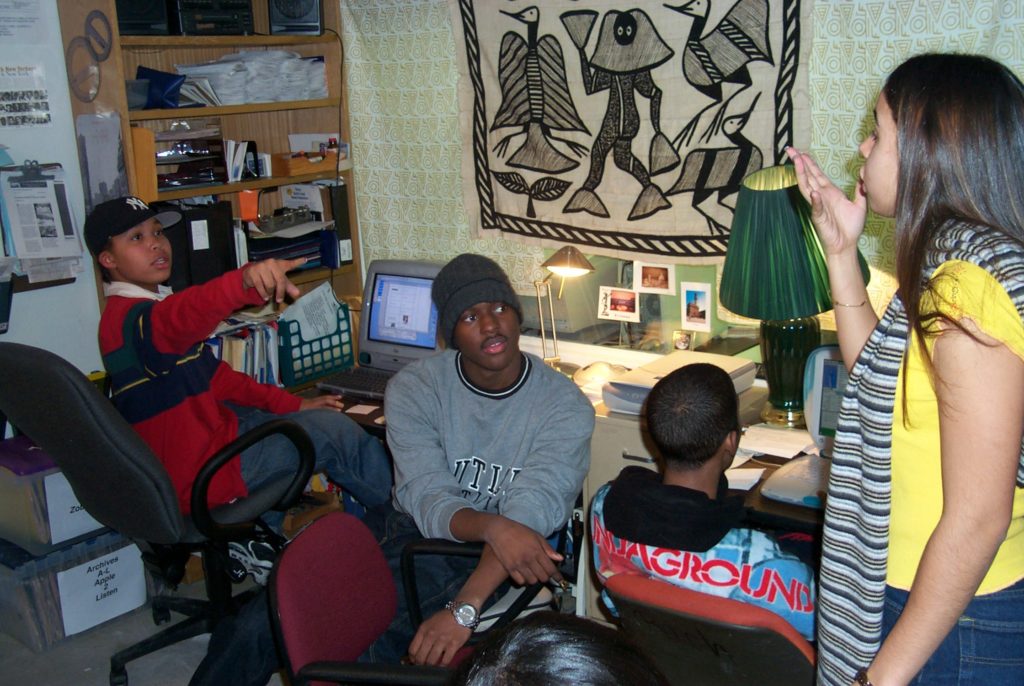
SPACE: Finding a Home with P2W
The move to Playing2Win’s East Harlem storefront was more than just a change of scenery for HarlemLIVE. This move meant exposure, immediacy, and a new level of dynamism. Where once we were hidden in a room in Teachers College, we were now front and center — a beacon of youthful energy and creativity. The atmosphere was electric; a hum of ideas being formed, stories being crafted, and young minds being shaped.
HarlemLIVE and P2W’s synergy was evident, a bond further solidified with the entrance of Mara Rose, fresh off her graduation from Teachers College. Her arrival marked a period characterized by mutual growth and collaboration. Mara recalls her initial encounter with the program and its infectious dynamism. She was met with challenges, but these challenges led to the forging of a partnership that thrived on shared values and mutual respect.
After graduating from Teachers College at Columbia University, I took on the role of reviving Playing2Win (P2W) under Boys Harbor, a nonprofit. P2W, located in a Harlem storefront, was in disrepair. Simultaneously, we integrated HarlemLIVE into P2W, creating a vibrant center. HarlemLIVE introduced an unconventional, student-centric approach, fostering individual talents, empowering leadership, and breaking traditional educational constraints. Collaboration between P2W and HarlemLIVE enabled mutual learning, with HarlemLIVE’s commitment to students driving innovative changes.
At HarlemLIVE, we believed in preparation. Before our reporters ventured out into the vibrant streets of Harlem or any other location, they were equipped with a checklist that ensured they were well-prepared.
When Going on a Story:
- Is Story Ticket (Sheet) Filled Out?
- Event Posted on HL online Calendar?
- Press Badges? (yours and others)
- HL Fliers
- Name of Org/Place/Event + Contact Person
- Information about …. (research)
- Address and Phone #s
- Cameras (check CHIPS and BATTERIES)
- Notepads and Pens
- Transportation Card and Sheet or Fare
- Tape Recorder (optional) / Walkie Talkies (*)
- Camera / Base / Tripod (optional)
- Batteries
- Headphones
- Microphone (wireless transmitters/receivers)
- Tapes – LABEL THEM!!
Returning from a story:
-
- Put pens, pads (take your notes out and put in your folder), badges and equipment away
- Debrief
- Download pics – LABEL CORRECTLY
- Type out notes / Write Reflections
- Recharge Batteries
- Put transportation card back
Empowerment Through Press Badges at HarlemLIVE
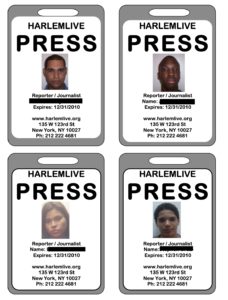 At HarlemLIVE, the press badges were a vital tool for empowerment and learning, especially for newcomers. These badges, printed four to an 8½” x 11″ card stock, were laminated for durability and separated, each with a hole punched at the top for a chain or colored lanyard. When worn around the neck, they signaled a professional approach and intention.
At HarlemLIVE, the press badges were a vital tool for empowerment and learning, especially for newcomers. These badges, printed four to an 8½” x 11″ card stock, were laminated for durability and separated, each with a hole punched at the top for a chain or colored lanyard. When worn around the neck, they signaled a professional approach and intention.
These badges served as more than just identification; they were symbols of trust and credibility. They informed interviewees that conversations were intended for publication, backed by the First Amendment rights of the U.S. Constitution. This aspect was crucial in opening doors to new opportunities and experiences for the students.
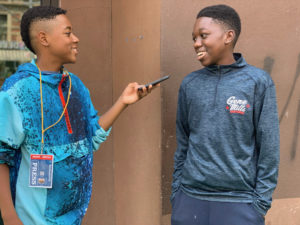 The badges granted access to spaces and individuals that might have been out of reach otherwise, playing a key role in the students’ journalistic empowerment. Through these badges, students interviewed influential figures and covered significant events, like celebrity appearances and critical community incidents, with newfound confidence and authority.
The badges granted access to spaces and individuals that might have been out of reach otherwise, playing a key role in the students’ journalistic empowerment. Through these badges, students interviewed influential figures and covered significant events, like celebrity appearances and critical community incidents, with newfound confidence and authority.
In essence, these press badges were not just pieces of plastic and lamination; they represented a transformation in the students’ lives, providing them with the tools and confidence to explore and report on their world.
The Heartbeat of Harlem: Pulse of the People
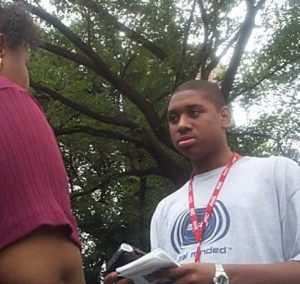
The hustle and bustle of Central Park became a regular backdrop for HarlemLIVE’s “Pulse of the People” (POP) interviews. More than just a reporting exercise, these street interviews became a transformative rite of passage for many of our students. From rookies learning the ropes to seasoned members guiding the way, the collaborative spirit of HarlemLIVE shone brightly during these excursions.
The First Taste of Journalism
Walking up to strangers and initiating conversations wasn’t everyone’s cup of tea, but it was an essential HarlemLIVE experience. With minimal training, we’d push our new members straight into the deep end. Yet, it wasn’t about throwing them under the bus; it was about teaching them to swim, to find their voice, and to shine.
Rite of Passage
The first POP interview was more than just an assignment; it was a transformative moment. The process was direct: “What news topics pique your interest?” After a newbie’s response, we’d transition to role-playing. How to initiate an interview, handle challenging respondents, and ensure the essence of the message was captured were all part of the drill. If the prospect of approaching strangers was too daunting for some, they’d start as photographers, capturing the essence of HarlemLIVE’s fieldwork through their lenses. HarlemLIVE was not just about journalism; it was about empowerment. It was about making sure each student knew their voice had value and teaching them to express themselves fearlessly. (See Creating Youth Journalists for more detailed instructions).
Student Voices: Growth and Transformation
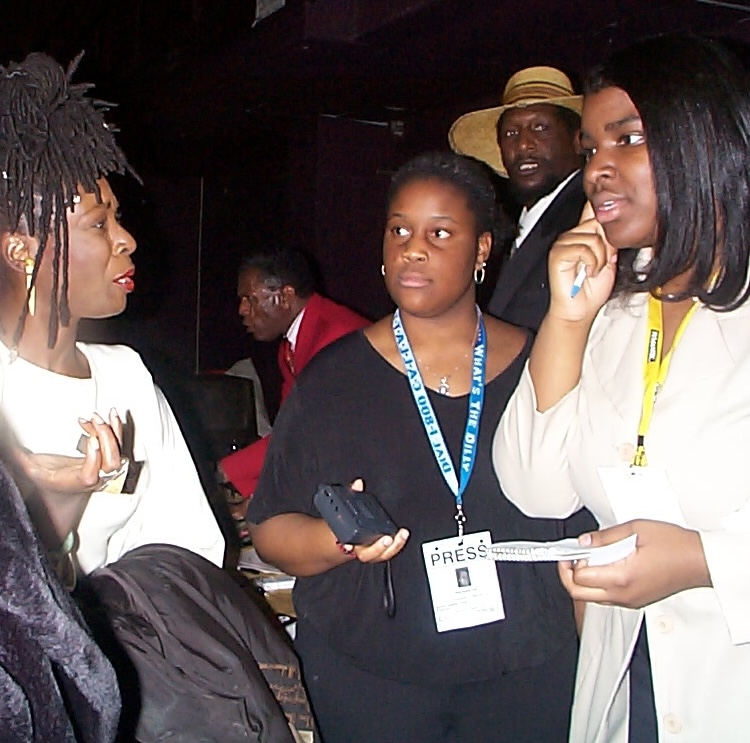
Tameeka Mitchem reflects: “HarlemLIVE opened me up socially. … It made me more aware of my ability to go out and get the things I want.”

Ena with actress, activist, writer Ruby Dee
And Ena Johnson, who encountered HarlemLIVE as a novice high schooler, adds: “HarlemLIVE had a tremendous impact on my life outlook and journey to self-actualization… This built in me a confidence I carried into adulthood.”
In this video, witnessed Stanley Antoine finishing up his very first attempt at doing a person-on-the-street interview.
Staying Connected: Choosing the Right Digital Communication Platform
Student Autonomy and Responsibility at HarlemLIVE
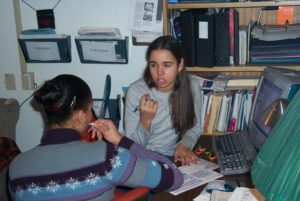
Christina Camacho interviews a prospective student
Taking Charge from Start to Finish Students at HarlemLIVE were not just passive recipients of knowledge; they were at the forefront of story creation and execution. From initiating a story to scheduling interviews and conducting administrative tasks, students were entrusted with substantial responsibilities.
Practical Preparation for Real-world Encounters HarlemLIVE equipped its students with practical tools and techniques, preparing them for the journalistic world outside the classroom. The teaching approach, involving role-play and scripts, bolstered their confidence and competency, encouraging a robust learning environment.
Alumni Reflections on HarlemLIVE’s Impact
Aisha Al-Muslim: “At HarlemLIVE, the reins were in our hands. We managed everything – from writing and video production to maintaining the office. This autonomy cultivated a sense of responsibility and editorial discernment, empowering me in my subsequent professional pursuits.”
Ebony Myers: “HarlemLIVE was more than a place to learn; it was a space where I grew personally and professionally. The freedom to explore stories across the city, coupled with encouragement and support, paved the way for overcoming fears and embracing the world of journalism with confidence and curiosity.”
Empowering through Peer Teaching and Professional Guidance Peer teaching was a cornerstone of HarlemLIVE’s approach, fostering a community of learners who shared knowledge and experiences. Professional volunteers enriched the learning environment, bringing industry insights and expertise into the students’ realm.
HarlemLIVE’s approach to journalism education was a unique blend of autonomy, responsibility, and real-world preparedness. This empowered students to navigate the world of journalism with confidence, knowledge, and a sense of ownership.
HarlemLIVE’s Checklists: A Detailed Breakdown
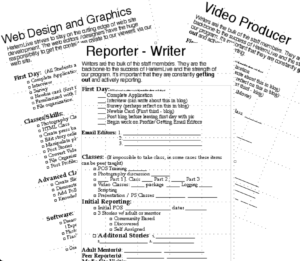 HarlemLIVE used detailed checklists to guide students through different learning areas such as journalism, photography, web design, tech, and administrative tasks. Here’s a closer look at how they worked:
HarlemLIVE used detailed checklists to guide students through different learning areas such as journalism, photography, web design, tech, and administrative tasks. Here’s a closer look at how they worked:
Purpose of the Checklists:
- Guidance: The checklists provided clear, step-by-step tasks, offering students a structured learning path.
- Autonomy: They allowed students to work at their own pace, promoting independence and self-guided learning.
Components of the Checklists:
- Specific Tasks: Each checklist contained specific tasks tailored to various learning areas, ensuring comprehensive coverage of necessary skills and knowledge.
- Peer Teaching: The checklists facilitated peer teaching, allowing experienced students to guide newer ones through different learning stages.
Professional Involvement:
- Industry Insights: Professionals from various fields volunteered to enhance the checklists with industry-standard knowledge and techniques, ensuring students received up-to-date and relevant training.
Usage:
- Versatility: Both new and experienced students used the checklists, ensuring everyone had access to a structured learning path.
- Flexibility: The checklists allowed students to manage their progress, ensuring that learning was self-paced and adaptable to each student’s needs.
In simple terms, the checklists were essential tools in HarlemLIVE’s educational approach, ensuring students had a clear, organized, and effective way to learn and develop their skills.
Empowering Voices: Public Speaking @ HarlemLIVE
At HarlemLIVE, we believed that the best person to tell a story is the one who lived it. Rooted in this belief, public speaking became an instrumental aspect of our educational arsenal. Inspired by real-life experiences and the foundational principles learned from esteemed platforms like the Dale Carnegie class, HarlemLIVE emboldened its youth to command stages, classrooms, and panels with authority and authenticity.
Navigating the Stage: A Journey from Inexperience to Expertise Our approach was simple yet transformative. After immersing themselves in various facets of our online magazine, our teens were equipped to stand before audiences, not just as speakers but as authorities in their fields. They didn’t just speak; they shared stories, experiences, and expertise that they had earned the right to talk about.
Beyond the Classroom: Taking Speech to Unconventional Platforms Our members were not limited to speaking within the familiar confines of HarlemLIVE or educational institutions. They ventured into diverse platforms, from high school classes within NYC’s Rikers Island prison to international stages in Vermont, sharing insights with audiences from Georgia, Pakistan, and beyond. These experiences weren’t mere speaking opportunities; they were chances to showcase resilience, knowledge, and the transformative power of the HarlemLIVE experience.
Stories of Transformation: In Their Own Words
Eddie, Shem, Katrina at Columbia Unviersity
Aisha Al-Muslim: “HarlemLIVE transformed my confidence. It was there that I learned the power of public speaking, sharing stories of our work and impact, which has become a crucial part of my career today.”
Treniese Ladson: “At HarlemLIVE, I found myself often in rooms full of people more educated, forcing me to overcome imposter syndrome. The confidence I built there wasn’t just about speaking; it was about asserting myself and reading the room, skills that have been indispensable in my career.”
Danya Steele: “HarlemLIVE wasn’t just a place to hone skills; it was a space that nurtured my confidence. Being one of the main public faces of HarlemLIVE, speaking on panels and conferences, allowed me to grow and navigate life’s complexities with a belief that ‘I can do this.’”
Kat Vorotova-Dey: “HarlemLIVE helped me overcome language barriers and fears, empowering me to approach public speaking with confidence. The practice I gained there propelled me in my career, ensuring that I never shied away from an opportunity to speak, share, and influence.”
HarlemLIVE’s Disruption: Redefining Youth’s Role in Public Speaking In the world outside HarlemLIVE, adults typically dominate the stage, especially when it comes to organizational representation. We flipped the script, placing our youth at the forefront. Their voices, charged with authenticity and passion, became our most potent narratives, illustrating HarlemLIVE’s impact and the immense capabilities of empowered youth.
Echoes Beyond HarlemLIVE: Long-lasting Impact on Careers and Lives The lessons learned and the confidence gained from speaking at HarlemLIVE didn’t just stay within our walls. They reverberated throughout the lives and careers of our members, equipping them with the ability to stand out in job interviews, dominate panel discussions, and shine on various platforms long after their HarlemLIVE journey.
In every speech, every presentation, HarlemLIVE’s speakers carried more than just words; they carried the embodiment of a transformative experience, proving that when the youth speak, the world doesn’t just listen; it stands in awe and applause.
Diverse Exposures: The Real Classroom of HarlemLIVE
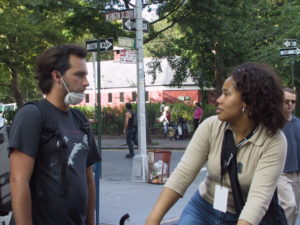 HarlemLIVE’s unique approach to education was about tossing the traditional classroom setting out the window and pushing students into the vast, vibrant, and unpredictable classroom of real-world experiences. Stationed in the media capital of the world, New York City, HarlemLIVE leveraged its location to expose students to a kaleidoscope of people, professions, and platforms. Students didn’t just learn journalism; they lived it, engaging with a diverse array of personalities from presidents to pop stars.
HarlemLIVE’s unique approach to education was about tossing the traditional classroom setting out the window and pushing students into the vast, vibrant, and unpredictable classroom of real-world experiences. Stationed in the media capital of the world, New York City, HarlemLIVE leveraged its location to expose students to a kaleidoscope of people, professions, and platforms. Students didn’t just learn journalism; they lived it, engaging with a diverse array of personalities from presidents to pop stars.
Danya Steele: “HarlemLIVE was more than an office; it was an arena of action. The encouragement to ‘Get out, be in action, use your youth,’ pushed us beyond conventional boundaries, turning the entire city into a dynamic learning space. It was a culture of curiosity and exploration, where our press badges were passports to opportunities and real-world learning.”
Johnny Alarcón: “HarlemLIVE urged us out of our comfort zones. Guided by a spirit of adventure and a buddy system, we navigated the streets, learning not just to report but to connect, engage, and empathize. It was about cultivating skills, courage, and kindness in the vibrant and varied classrooms of New York City.”
This approach not just enriched their journalistic skills but broadened their horizons, allowing them to glean knowledge, experience, and stories from the colorful and diverse tapestry of the city’s life. Students found themselves navigating new environments, from the glamour of award shows to the gritty streets, engaging with a spectrum that spanned from Hillary Clinton to Jay Z.
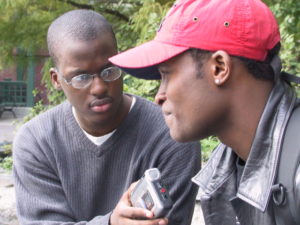 The essence of HarlemLIVE’s teaching philosophy was not about telling tales but living them first, ensuring each student had a rich reservoir of experiences and stories to share, making learning not just informative but profoundly transformative.
The essence of HarlemLIVE’s teaching philosophy was not about telling tales but living them first, ensuring each student had a rich reservoir of experiences and stories to share, making learning not just informative but profoundly transformative.

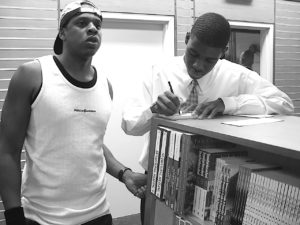
A Visionary Project: The Clickable Map of Harlem
HarlemLIVE embarked on an extraordinary project: creating an interactive, comprehensive map of Harlem. Before Google Maps became a ubiquitous tool, our young team set out on a mission—document every block of Harlem, capturing the essence of neighborhoods, streets, and communities through photographs and descriptions.
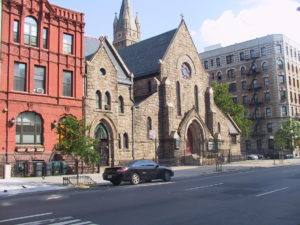 The ‘Clickable Map of Harlem’ not only fostered technical skills in photography and digital mapping among the youth but also ignited curiosity and engagement within the Harlem community. People began to recognize the HarlemLIVE team, approaching them with interest and inquiries about the project. It was a unique blend of technology and community involvement, allowing students to explore and connect more deeply with the neighborhoods they were documenting.
The ‘Clickable Map of Harlem’ not only fostered technical skills in photography and digital mapping among the youth but also ignited curiosity and engagement within the Harlem community. People began to recognize the HarlemLIVE team, approaching them with interest and inquiries about the project. It was a unique blend of technology and community involvement, allowing students to explore and connect more deeply with the neighborhoods they were documenting.
Despite facing challenges, such as the evolving technological landscape and the obsolescence of the Flash platform, the project symbolized more than a digital achievement. It was about process, learning, and the growth that came from attempting something innovative and challenging.
HarlemLIVE’s project left a powerful imprint, epitomizing a commitment to community, technology, and the educational growth of our youth, ensuring they were equipped, inspired, and ready to make meaningful contributions to the technological world.
HarlemLIVE wasn’t just about teaching journalism; it was a platform where young voices flourished. The youth learned more than just technical skills—they discovered the influence and reach of their own voices. The experience at HarlemLIVE didn’t just stay with them as a memory but actively shaped their futures and career trajectories.
DISCUSSION TOPICS:
Why is it important for students to engage in authentic experiences in their education?
- Real-World Application: By engaging in authentic experiences, students not only learn theoretical knowledge but also understand how it applies to real-world situations. They can better see the relevance and value of what they’re learning.
- Development of Critical Skills: Facing genuine challenges helps youth develop essential life skills, such as problem-solving, communication, adaptability, and perseverance. It’s one thing to talk about a skill; it’s another to put it into practice.
- Boosting Confidence: By succeeding in real situations (or learning from failures), youth gain confidence in their abilities. They learn they can handle challenges and that they have valuable contributions to make.
- Fostering Independence: Authentic experiences encourage students to think for themselves, make decisions, and take ownership of their actions. This nurtures independence and a sense of agency.
- Resilience Building: Facing real challenges and, at times, experiencing real failures, helps youth build resilience. They learn that setbacks are a part of life and can be overcome.
- Preparation for the Future: The real world won’t shield them from challenges. By facing genuine experiences now, they’re better prepared for future challenges in work and life.
- Deep Learning: Authentic experiences often lead to deeper learning and understanding. Instead of surface-level memorization, students engage with concepts at a much more profound and personal level.
Empowering Youth: Insights and Lessons from HarlemLIVE’s Approach
In chapter 8, there was mention of how some adults felt they should make the initial phone calls ahead of the students who were to set up the interviews. This was totally antithetical to the mission of HarlemLIVE.
The perspective of wanting adults to make initial contact before youth reach out for interviews likely stems from a combination of protective instincts, perceptions about professionalism, and potential underestimations of youth capability. Here are some reasons adults might have felt this way:
Protective Instincts: Adults often have an instinctual desire to shield young people from potential harm, disappointment, or rejection. By making the initial call themselves, they might believe they are creating a smoother path for the youth, ensuring they don’t face any rudeness or dismissals.
Perceived Professionalism: Some adults may believe that a call coming from another adult, especially one associated with the program, would be taken more seriously or be seen as more professional by the potential interviewee. This perspective assumes that adults will be more successful in setting the stage for the interview.
Underestimation of Youth Capability: There’s often an implicit bias where adults may underestimate the capabilities of young people. They might think that youth aren’t mature, skilled, or persuasive enough to secure an interview on their own, even though, with proper training and scripts, many youth can handle these tasks quite adeptly.
Fear of Negative Reflection on the Program: There might be concerns that if a young person doesn’t handle the call “perfectly,” it could reflect poorly on the entire program. By having an adult make the initial call, they may believe they are ensuring the program is always presented in the best light.
Concerns about Misunderstandings or Miscommunications: Adults might worry that youth won’t communicate all the necessary details accurately or might miss out on capturing essential information, leading to confusion or misunderstandings.
Cultural or Societal Norms: In some cultures or societal structures, it’s customary for elders or those in perceived positions of authority to initiate communications or establish relationships. It might be seen as a sign of respect or propriety.
While these reasons might explain why some adults feel the way they do, it’s crucial, especially in a program like HarlemLIVE that aims to empower youth, to trust young people with responsibilities and let them navigate real-world experiences. The learning that comes from such direct interactions is invaluable and can’t be replicated by shielding or doing tasks on their behalf.
For anyone seeking to understand or replicate a successful youth engagement model, chapter 8 provides invaluable insights. Here are some key takeaways:
Structured Autonomy: HarlemLIVE demonstrated the importance of balancing structure with autonomy. The use of story tickets, training checklists, and newbie cards provided guidance while still granting students significant independence.
Empowerment Through Responsibility: We make a compelling case for entrusting youth with responsibility. This not only made them invested stakeholders but also rapidly accelerated their learning and growth.
Diverse Exposure: The myriad experiences, from interviewing prominent personalities to documenting every block of Harlem, underlined the significance of exposing youth to diverse situations to broaden their horizons.
Peer Teaching & Mentorship: HarlemLIVE’s model emphasized the value of peer teaching and mentorship, showcasing how the absence of a hierarchical structure can still result in effective learning.
Value of Authentic Experience: The program’s real-world approach to journalism and media meant students faced genuine challenges and learned from them.
Incorporating Technology: The focus on modern tools, from Apple computers to early online chat platforms, underscored the importance of integrating technology into educational and engagement models.
Evolution & Adaptability: The program’s readiness to evolve, whether it was adapting to new technological platforms or adjusting strategies based on challenges, highlighted the importance of being nimble and adaptive.
Listening to Youth Voices: The numerous testimonials emphasized the importance of truly listening to young people, understanding their perspectives, and valuing their contributions.
Real-world Preparedness: HarlemLIVE’s approach was geared not just towards immediate tasks but towards preparing students for the real world, from public speaking to networking.
For educators, youth program organizers, community leaders, and anyone passionate about youth empowerment, this chapter offers a goldmine of practical insights, strategies, and anecdotes that can inform and inspire.
When Going on a Story:
- Is Story Ticket (Sheet) Filled Out?
- Event Posted on HL online Calendar?
- Press Badges? (yours and others)
- HL Fliers
- Name of Org/Place/Event + Contact Person
- Information about …. (research)
- Address and Phone #s
- Cameras (check CHIPS and BATTERIES)
- Notepads and Pens
- Transportation Card and Sheet or Fare
- Tape Recorder (optional) / Walkie Talkies (*)
- Camera / Base / Tripod (optional)
- Batteries
- Headphones
- Microphone (wireless transmitters/receivers)
- Tapes – LABEL THEM!!
Returning from a story:
-
- Put pens, pads (take your notes out and put in your folder), badges and equipment away
- Debrief
- Download pics – LABEL CORRECTLY
- Type out notes / Write Reflections
- Recharge Batteries
- Put transportation card back
[/vc_column_text]
Empowerment Through Press Badges at HarlemLIVE
 At HarlemLIVE, the press badges were a vital tool for empowerment and learning, especially for newcomers. These badges, printed four to an 8½” x 11″ card stock, were laminated for durability and separated, each with a hole punched at the top for a chain or colored lanyard. When worn around the neck, they signaled a professional approach and intention.
At HarlemLIVE, the press badges were a vital tool for empowerment and learning, especially for newcomers. These badges, printed four to an 8½” x 11″ card stock, were laminated for durability and separated, each with a hole punched at the top for a chain or colored lanyard. When worn around the neck, they signaled a professional approach and intention.
These badges served as more than just identification; they were symbols of trust and credibility. They informed interviewees that conversations were intended for publication, backed by the First Amendment rights of the U.S. Constitution. This aspect was crucial in opening doors to new opportunities and experiences for the students.
 The badges granted access to spaces and individuals that might have been out of reach otherwise, playing a key role in the students’ journalistic empowerment. Through these badges, students interviewed influential figures and covered significant events, like celebrity appearances and critical community incidents, with newfound confidence and authority.
The badges granted access to spaces and individuals that might have been out of reach otherwise, playing a key role in the students’ journalistic empowerment. Through these badges, students interviewed influential figures and covered significant events, like celebrity appearances and critical community incidents, with newfound confidence and authority.
In essence, these press badges were not just pieces of plastic and lamination; they represented a transformation in the students’ lives, providing them with the tools and confidence to explore and report on their world.
The Heartbeat of Harlem: Pulse of the People

The hustle and bustle of Central Park became a regular backdrop for HarlemLIVE’s “Pulse of the People” (POP) interviews. More than just a reporting exercise, these street interviews became a transformative rite of passage for many of our students. From rookies learning the ropes to seasoned members guiding the way, the collaborative spirit of HarlemLIVE shone brightly during these excursions.
The First Taste of Journalism
Walking up to strangers and initiating conversations wasn’t everyone’s cup of tea, but it was an essential HarlemLIVE experience. With minimal training, we’d push our new members straight into the deep end. Yet, it wasn’t about throwing them under the bus; it was about teaching them to swim, to find their voice, and to shine.
Rite of Passage
The first POP interview was more than just an assignment; it was a transformative moment. The process was direct: “What news topics pique your interest?” After a newbie’s response, we’d transition to role-playing. How to initiate an interview, handle challenging respondents, and ensure the essence of the message was captured were all part of the drill. If the prospect of approaching strangers was too daunting for some, they’d start as photographers, capturing the essence of HarlemLIVE’s fieldwork through their lenses. HarlemLIVE was not just about journalism; it was about empowerment. It was about making sure each student knew their voice had value and teaching them to express themselves fearlessly. (See Creating Youth Journalists for more detailed instructions).
Student Voices: Growth and Transformation

Tameeka Mitchem reflects: “HarlemLIVE opened me up socially. … It made me more aware of my ability to go out and get the things I want.”

Ena with actress, activist, writer Ruby Dee
And Ena Johnson, who encountered HarlemLIVE as a novice high schooler, adds: “HarlemLIVE had a tremendous impact on my life outlook and journey to self-actualization… This built in me a confidence I carried into adulthood.”
In this video, witnessed Stanley Antoine finishing up his very first attempt at doing a person-on-the-street interview.
Staying Connected: Choosing the Right Digital Communication Platform
Student Autonomy and Responsibility at HarlemLIVE

Christina Camacho interviews a prospective student
Taking Charge from Start to Finish Students at HarlemLIVE were not just passive recipients of knowledge; they were at the forefront of story creation and execution. From initiating a story to scheduling interviews and conducting administrative tasks, students were entrusted with substantial responsibilities.
Practical Preparation for Real-world Encounters HarlemLIVE equipped its students with practical tools and techniques, preparing them for the journalistic world outside the classroom. The teaching approach, involving role-play and scripts, bolstered their confidence and competency, encouraging a robust learning environment.
Alumni Reflections on HarlemLIVE’s Impact
Aisha Al-Muslim: “At HarlemLIVE, the reins were in our hands. We managed everything – from writing and video production to maintaining the office. This autonomy cultivated a sense of responsibility and editorial discernment, empowering me in my subsequent professional pursuits.”
Ebony Myers: “HarlemLIVE was more than a place to learn; it was a space where I grew personally and professionally. The freedom to explore stories across the city, coupled with encouragement and support, paved the way for overcoming fears and embracing the world of journalism with confidence and curiosity.”
Empowering through Peer Teaching and Professional Guidance Peer teaching was a cornerstone of HarlemLIVE’s approach, fostering a community of learners who shared knowledge and experiences. Professional volunteers enriched the learning environment, bringing industry insights and expertise into the students’ realm.
HarlemLIVE’s approach to journalism education was a unique blend of autonomy, responsibility, and real-world preparedness. This empowered students to navigate the world of journalism with confidence, knowledge, and a sense of ownership.
HarlemLIVE’s Checklists: A Detailed Breakdown
 HarlemLIVE used detailed checklists to guide students through different learning areas such as journalism, photography, web design, tech, and administrative tasks. Here’s a closer look at how they worked:
HarlemLIVE used detailed checklists to guide students through different learning areas such as journalism, photography, web design, tech, and administrative tasks. Here’s a closer look at how they worked:
Purpose of the Checklists:
- Guidance: The checklists provided clear, step-by-step tasks, offering students a structured learning path.
- Autonomy: They allowed students to work at their own pace, promoting independence and self-guided learning.
Components of the Checklists:
- Specific Tasks: Each checklist contained specific tasks tailored to various learning areas, ensuring comprehensive coverage of necessary skills and knowledge.
- Peer Teaching: The checklists facilitated peer teaching, allowing experienced students to guide newer ones through different learning stages.
Professional Involvement:
- Industry Insights: Professionals from various fields volunteered to enhance the checklists with industry-standard knowledge and techniques, ensuring students received up-to-date and relevant training.
Usage:
- Versatility: Both new and experienced students used the checklists, ensuring everyone had access to a structured learning path.
- Flexibility: The checklists allowed students to manage their progress, ensuring that learning was self-paced and adaptable to each student’s needs.
In simple terms, the checklists were essential tools in HarlemLIVE’s educational approach, ensuring students had a clear, organized, and effective way to learn and develop their skills.
Empowering Voices: Public Speaking @ HarlemLIVE
At HarlemLIVE, we believed that the best person to tell a story is the one who lived it. Rooted in this belief, public speaking became an instrumental aspect of our educational arsenal. Inspired by real-life experiences and the foundational principles learned from esteemed platforms like the Dale Carnegie class, HarlemLIVE emboldened its youth to command stages, classrooms, and panels with authority and authenticity.
Navigating the Stage: A Journey from Inexperience to Expertise Our approach was simple yet transformative. After immersing themselves in various facets of our online magazine, our teens were equipped to stand before audiences, not just as speakers but as authorities in their fields. They didn’t just speak; they shared stories, experiences, and expertise that they had earned the right to talk about.
Beyond the Classroom: Taking Speech to Unconventional Platforms Our members were not limited to speaking within the familiar confines of HarlemLIVE or educational institutions. They ventured into diverse platforms, from high school classes within NYC’s Rikers Island prison to international stages in Vermont, sharing insights with audiences from Georgia, Pakistan, and beyond. These experiences weren’t mere speaking opportunities; they were chances to showcase resilience, knowledge, and the transformative power of the HarlemLIVE experience.
Stories of Transformation: In Their Own Words
Eddie, Shem, Katrina at Columbia Unviersity
Aisha Al-Muslim: “HarlemLIVE transformed my confidence. It was there that I learned the power of public speaking, sharing stories of our work and impact, which has become a crucial part of my career today.”
Treniese Ladson: “At HarlemLIVE, I found myself often in rooms full of people more educated, forcing me to overcome imposter syndrome. The confidence I built there wasn’t just about speaking; it was about asserting myself and reading the room, skills that have been indispensable in my career.”
Danya Steele: “HarlemLIVE wasn’t just a place to hone skills; it was a space that nurtured my confidence. Being one of the main public faces of HarlemLIVE, speaking on panels and conferences, allowed me to grow and navigate life’s complexities with a belief that ‘I can do this.’”
Kat Vorotova-Dey: “HarlemLIVE helped me overcome language barriers and fears, empowering me to approach public speaking with confidence. The practice I gained there propelled me in my career, ensuring that I never shied away from an opportunity to speak, share, and influence.”
HarlemLIVE’s Disruption: Redefining Youth’s Role in Public Speaking In the world outside HarlemLIVE, adults typically dominate the stage, especially when it comes to organizational representation. We flipped the script, placing our youth at the forefront. Their voices, charged with authenticity and passion, became our most potent narratives, illustrating HarlemLIVE’s impact and the immense capabilities of empowered youth.
Echoes Beyond HarlemLIVE: Long-lasting Impact on Careers and Lives The lessons learned and the confidence gained from speaking at HarlemLIVE didn’t just stay within our walls. They reverberated throughout the lives and careers of our members, equipping them with the ability to stand out in job interviews, dominate panel discussions, and shine on various platforms long after their HarlemLIVE journey.
In every speech, every presentation, HarlemLIVE’s speakers carried more than just words; they carried the embodiment of a transformative experience, proving that when the youth speak, the world doesn’t just listen; it stands in awe and applause.
Diverse Exposures: The Real Classroom of HarlemLIVE
 HarlemLIVE’s unique approach to education was about tossing the traditional classroom setting out the window and pushing students into the vast, vibrant, and unpredictable classroom of real-world experiences. Stationed in the media capital of the world, New York City, HarlemLIVE leveraged its location to expose students to a kaleidoscope of people, professions, and platforms. Students didn’t just learn journalism; they lived it, engaging with a diverse array of personalities from presidents to pop stars.
HarlemLIVE’s unique approach to education was about tossing the traditional classroom setting out the window and pushing students into the vast, vibrant, and unpredictable classroom of real-world experiences. Stationed in the media capital of the world, New York City, HarlemLIVE leveraged its location to expose students to a kaleidoscope of people, professions, and platforms. Students didn’t just learn journalism; they lived it, engaging with a diverse array of personalities from presidents to pop stars.
Danya Steele: “HarlemLIVE was more than an office; it was an arena of action. The encouragement to ‘Get out, be in action, use your youth,’ pushed us beyond conventional boundaries, turning the entire city into a dynamic learning space. It was a culture of curiosity and exploration, where our press badges were passports to opportunities and real-world learning.”
Johnny Alarcón: “HarlemLIVE urged us out of our comfort zones. Guided by a spirit of adventure and a buddy system, we navigated the streets, learning not just to report but to connect, engage, and empathize. It was about cultivating skills, courage, and kindness in the vibrant and varied classrooms of New York City.”
This approach not just enriched their journalistic skills but broadened their horizons, allowing them to glean knowledge, experience, and stories from the colorful and diverse tapestry of the city’s life. Students found themselves navigating new environments, from the glamour of award shows to the gritty streets, engaging with a spectrum that spanned from Hillary Clinton to Jay Z.
 The essence of HarlemLIVE’s teaching philosophy was not about telling tales but living them first, ensuring each student had a rich reservoir of experiences and stories to share, making learning not just informative but profoundly transformative.
The essence of HarlemLIVE’s teaching philosophy was not about telling tales but living them first, ensuring each student had a rich reservoir of experiences and stories to share, making learning not just informative but profoundly transformative.


A Visionary Project: The Clickable Map of Harlem
HarlemLIVE embarked on an extraordinary project: creating an interactive, comprehensive map of Harlem. Before Google Maps became a ubiquitous tool, our young team set out on a mission—document every block of Harlem, capturing the essence of neighborhoods, streets, and communities through photographs and descriptions.
 The ‘Clickable Map of Harlem’ not only fostered technical skills in photography and digital mapping among the youth but also ignited curiosity and engagement within the Harlem community. People began to recognize the HarlemLIVE team, approaching them with interest and inquiries about the project. It was a unique blend of technology and community involvement, allowing students to explore and connect more deeply with the neighborhoods they were documenting.
The ‘Clickable Map of Harlem’ not only fostered technical skills in photography and digital mapping among the youth but also ignited curiosity and engagement within the Harlem community. People began to recognize the HarlemLIVE team, approaching them with interest and inquiries about the project. It was a unique blend of technology and community involvement, allowing students to explore and connect more deeply with the neighborhoods they were documenting.
Despite facing challenges, such as the evolving technological landscape and the obsolescence of the Flash platform, the project symbolized more than a digital achievement. It was about process, learning, and the growth that came from attempting something innovative and challenging.
HarlemLIVE’s project left a powerful imprint, epitomizing a commitment to community, technology, and the educational growth of our youth, ensuring they were equipped, inspired, and ready to make meaningful contributions to the technological world.
HarlemLIVE wasn’t just about teaching journalism; it was a platform where young voices flourished. The youth learned more than just technical skills—they discovered the influence and reach of their own voices. The experience at HarlemLIVE didn’t just stay with them as a memory but actively shaped their futures and career trajectories.
DISCUSSION TOPICS:
Why is it important for students to engage in authentic experiences in their education?
- Real-World Application: By engaging in authentic experiences, students not only learn theoretical knowledge but also understand how it applies to real-world situations. They can better see the relevance and value of what they’re learning.
- Development of Critical Skills: Facing genuine challenges helps youth develop essential life skills, such as problem-solving, communication, adaptability, and perseverance. It’s one thing to talk about a skill; it’s another to put it into practice.
- Boosting Confidence: By succeeding in real situations (or learning from failures), youth gain confidence in their abilities. They learn they can handle challenges and that they have valuable contributions to make.
- Fostering Independence: Authentic experiences encourage students to think for themselves, make decisions, and take ownership of their actions. This nurtures independence and a sense of agency.
- Resilience Building: Facing real challenges and, at times, experiencing real failures, helps youth build resilience. They learn that setbacks are a part of life and can be overcome.
- Preparation for the Future: The real world won’t shield them from challenges. By facing genuine experiences now, they’re better prepared for future challenges in work and life.
- Deep Learning: Authentic experiences often lead to deeper learning and understanding. Instead of surface-level memorization, students engage with concepts at a much more profound and personal level.
Empowering Youth: Insights and Lessons from HarlemLIVE’s Approach
In chapter 8, there was mention of how some adults felt they should make the initial phone calls ahead of the students who were to set up the interviews. This was totally antithetical to the mission of HarlemLIVE.
The perspective of wanting adults to make initial contact before youth reach out for interviews likely stems from a combination of protective instincts, perceptions about professionalism, and potential underestimations of youth capability. Here are some reasons adults might have felt this way:
Protective Instincts: Adults often have an instinctual desire to shield young people from potential harm, disappointment, or rejection. By making the initial call themselves, they might believe they are creating a smoother path for the youth, ensuring they don’t face any rudeness or dismissals.
Perceived Professionalism: Some adults may believe that a call coming from another adult, especially one associated with the program, would be taken more seriously or be seen as more professional by the potential interviewee. This perspective assumes that adults will be more successful in setting the stage for the interview.
Underestimation of Youth Capability: There’s often an implicit bias where adults may underestimate the capabilities of young people. They might think that youth aren’t mature, skilled, or persuasive enough to secure an interview on their own, even though, with proper training and scripts, many youth can handle these tasks quite adeptly.
Fear of Negative Reflection on the Program: There might be concerns that if a young person doesn’t handle the call “perfectly,” it could reflect poorly on the entire program. By having an adult make the initial call, they may believe they are ensuring the program is always presented in the best light.
Concerns about Misunderstandings or Miscommunications: Adults might worry that youth won’t communicate all the necessary details accurately or might miss out on capturing essential information, leading to confusion or misunderstandings.
Cultural or Societal Norms: In some cultures or societal structures, it’s customary for elders or those in perceived positions of authority to initiate communications or establish relationships. It might be seen as a sign of respect or propriety.
While these reasons might explain why some adults feel the way they do, it’s crucial, especially in a program like HarlemLIVE that aims to empower youth, to trust young people with responsibilities and let them navigate real-world experiences. The learning that comes from such direct interactions is invaluable and can’t be replicated by shielding or doing tasks on their behalf.
For anyone seeking to understand or replicate a successful youth engagement model, chapter 8 provides invaluable insights. Here are some key takeaways:
Structured Autonomy: HarlemLIVE demonstrated the importance of balancing structure with autonomy. The use of story tickets, training checklists, and newbie cards provided guidance while still granting students significant independence.
Empowerment Through Responsibility: We make a compelling case for entrusting youth with responsibility. This not only made them invested stakeholders but also rapidly accelerated their learning and growth.
Diverse Exposure: The myriad experiences, from interviewing prominent personalities to documenting every block of Harlem, underlined the significance of exposing youth to diverse situations to broaden their horizons.
Peer Teaching & Mentorship: HarlemLIVE’s model emphasized the value of peer teaching and mentorship, showcasing how the absence of a hierarchical structure can still result in effective learning.
Value of Authentic Experience: The program’s real-world approach to journalism and media meant students faced genuine challenges and learned from them.
Incorporating Technology: The focus on modern tools, from Apple computers to early online chat platforms, underscored the importance of integrating technology into educational and engagement models.
Evolution & Adaptability: The program’s readiness to evolve, whether it was adapting to new technological platforms or adjusting strategies based on challenges, highlighted the importance of being nimble and adaptive.
Listening to Youth Voices: The numerous testimonials emphasized the importance of truly listening to young people, understanding their perspectives, and valuing their contributions.
Real-world Preparedness: HarlemLIVE’s approach was geared not just towards immediate tasks but towards preparing students for the real world, from public speaking to networking.
For educators, youth program organizers, community leaders, and anyone passionate about youth empowerment, this chapter offers a goldmine of practical insights, strategies, and anecdotes that can inform and inspire.
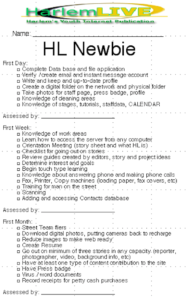 At HarlemLIVE, embarking on the journey as a new member involved much more than just filling out an application form. It meant becoming part of a dynamic and passionate community, embracing its culture, and contributing to its vibrancy. To facilitate this integration, each newcomer received a “Newbie” card, acting as a comprehensive guide for their initial period in the program.
At HarlemLIVE, embarking on the journey as a new member involved much more than just filling out an application form. It meant becoming part of a dynamic and passionate community, embracing its culture, and contributing to its vibrancy. To facilitate this integration, each newcomer received a “Newbie” card, acting as a comprehensive guide for their initial period in the program.The Newbie card outlined a structured approach for the initial days, ensuring a smooth and inclusive start for every individual.
[/vc_column_text][/vc_column_inner][/vc_row_inner]
First Day:
- Familiarize yourself with cleaning areas.
- Take photos for staff page, press badge, and profile.
- Create a digital folder on the network and a physical folder.
- Write and keep an up-to-date profile.Create email and instant message account.
- Complete database and file application.
- Understand the stages, tutorials, staff data, and the HL CALENDAR.
Assessed by: [Name of the Assessor (HL Veteran or Alum generally)]
First Week:
- Ensure you have your Press badge.
- Begin learning touch typing.
- Determine your interests and set goals.
- Review guides created by editors, gather story and project ideas.
- Familiarize yourself with the checklist for going out on stories.
- Attend the Orientation Meeting (understand the story sheet and HarlemLIVE’s mission).
- Learn how to access the server from any computer.
- Understand the work areas.
- Learn phone etiquette for answering and making calls.
- Receive training for ‘man on the street’ interviews.
- Understand how to use the fax, printer, and copy machines (like loading paper and using fax covers).
- Learn scanning techniques.
- Add and access the Contacts database.
Assessed by: [Name of the Assessor]
First Month:
- Download digital photos and ensure cameras are put back to recharge.
- Resize images to make them web-ready.
- Create a resume.
- Participate in at least three stories in any capacity (reporter, photographer, videographer; gather background info, etc).
- Contribute at least one type of content to the site.
- Familiarize yourself with the process of virus checks or other tech necessities.
- Record receipts for petty cash purchases.
Assessed by:</strong id=”storyworkflow”> [Name of the Assessor]
The Story Ticket System at HarlemLIVE
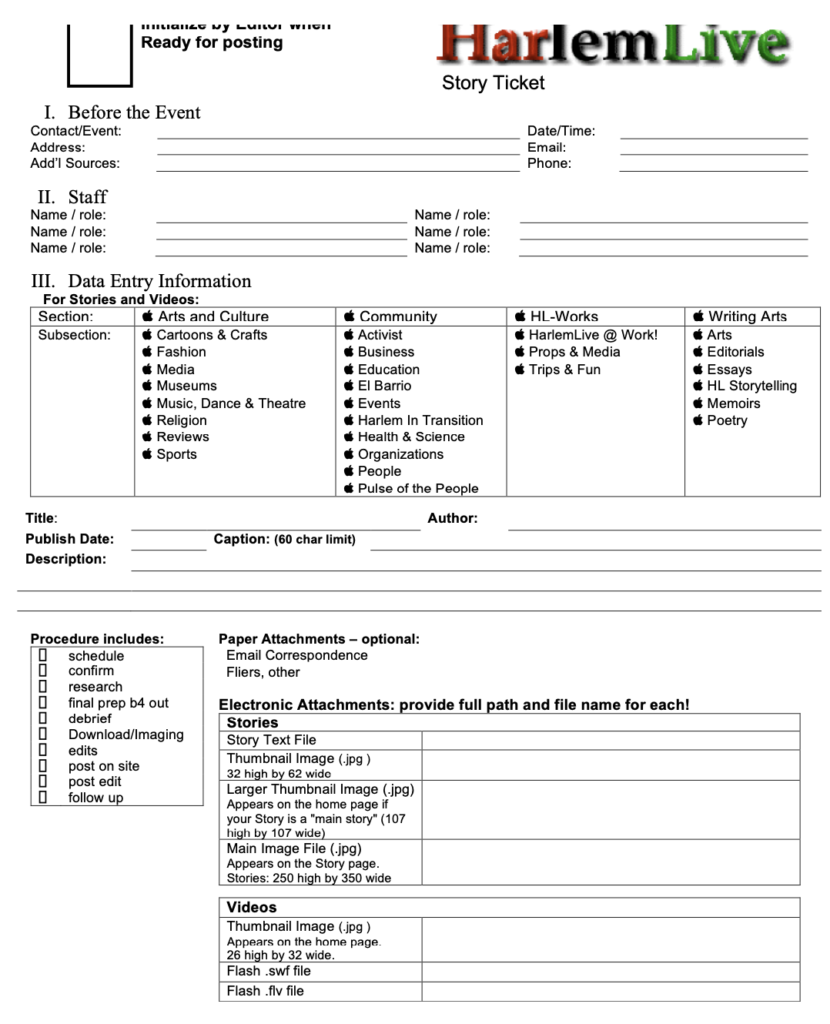
Story Tickets were used to keep track of the stories. This evolved over time.
The “Story Ticket” utilized at HarlemLIVE was an instrumental tool designed to meticulously organize the entire lifecycle of a story, right from its conception to publication. Each Story Ticket served as a comprehensive repository, encapsulating vital information necessary for story development and eventual posting on the website.
Here is an expansion on the content elements of the Story Ticket:
I. Before the Event
- Contact/Event: Details of the event or person being covered by the story.
- Address: Location details of the event.
- Additional Sources: Any supplementary information or sources related to the story.
II. Staff Names / Roles
- Assigned Students and Advising Adults: Identification of the students and mentors involved in the story creation process.
III. Data Entry Information for Stories and Videos
- Data Entry Personnel: Individuals responsible for entering data related to the story or video.
- Section and Subsection: Classification of the story based on its thematic content, dividing it into various sections and subsections such as Arts and Culture, Community, Sports, etc.
Story Details
- Title: The title of the story.
- Publish Date: Planned publication date for the story.
- Description: A brief overview or summary of the story content.
- Author: Attribution to the person or persons responsible for creating the story.
- Caption: A concise caption accompanying the story (limited to 60 characters).
Procedure
- Procedure Steps: Detailed steps outlining the process to follow, including confirming schedules, conducting research, final preparations before going out for coverage, post-interview debrief, download, imaging edits, site posting, editing follow-ups, etc.
Attachments
- Paper Attachments: Optional physical documents related to the story, such as emails, fliers, or other print materials.
- Electronic Attachments: Full paths and filenames of electronic files associated with the story, including text files, images (thumbnails, larger thumbnails, and main images), flash files for videos, etc.
This detailed breakdown within the Story Ticket ensured that all necessary information, tasks, and resources required for the successful creation and publication of a story were methodically recorded and managed, contributing to an organized and efficient workflow for the HarlemLIVE team.
Our Organization System
We used a visible wall-mounted system of five ‘pockets’ to manage the progress of stories:
- Potential Stories: This folder contained initial ideas and upcoming events that were not yet assigned.
- Scheduled Stories: This held stories with arranged interviews and preliminary student assignments.
- Reported Stories / Stories in Editing Process: Here were stories that had completed reporting and were undergoing editing.
- Ready for Publication: Stories that were edited and finalized were kept here, ready for website upload.
- Stories to be Archived: Completed stories that were no longer current were moved here for record-keeping.
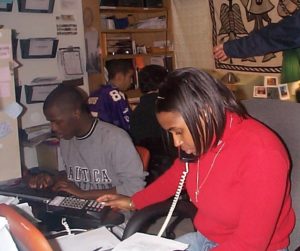
You can see some of the wall pockets we used to track progress of stories
Balancing Old and New: While we tried digital tracking systems, we found that a physical, hands-on method was sometimes more effective and easy to understand at a glance for both team members and visitors.
Personal Spaces: We also provided individual mailboxes for volunteers, giving them a personal space to keep their notes and documents organized.
This straightforward system allowed for effective tracking and management of stories, ensuring that each one moved smoothly through the process from idea to publication.
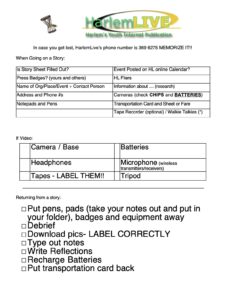
HarlemLIVE On-the-Go: The Essential Checklist
At HarlemLIVE, we believed in preparation. Before our reporters ventured out into the vibrant streets of Harlem or any other location, they were equipped with a checklist that ensured they were well-prepared.
When Going on a Story:
- Is Story Ticket (Sheet) Filled Out?
- Event Posted on HL online Calendar?
- Press Badges? (yours and others)
- HL Fliers
- Name of Org/Place/Event + Contact Person
- Information about …. (research)
- Address and Phone #s
- Cameras (check CHIPS and BATTERIES)
- Notepads and Pens
- Transportation Card and Sheet or Fare
- Tape Recorder (optional) / Walkie Talkies (*)
- Camera / Base / Tripod (optional)
- Batteries
- Headphones
- Microphone (wireless transmitters/receivers)
- Tapes – LABEL THEM!!
Returning from a story:
-
- Put pens, pads (take your notes out and put in your folder), badges and equipment away
- Debrief
- Download pics – LABEL CORRECTLY
- Type out notes / Write Reflections
- Recharge Batteries
- Put transportation card back
Empowerment Through Press Badges at HarlemLIVE
 At HarlemLIVE, the press badges were a vital tool for empowerment and learning, especially for newcomers. These badges, printed four to an 8½” x 11″ card stock, were laminated for durability and separated, each with a hole punched at the top for a chain or colored lanyard. When worn around the neck, they signaled a professional approach and intention.
At HarlemLIVE, the press badges were a vital tool for empowerment and learning, especially for newcomers. These badges, printed four to an 8½” x 11″ card stock, were laminated for durability and separated, each with a hole punched at the top for a chain or colored lanyard. When worn around the neck, they signaled a professional approach and intention.
These badges served as more than just identification; they were symbols of trust and credibility. They informed interviewees that conversations were intended for publication, backed by the First Amendment rights of the U.S. Constitution. This aspect was crucial in opening doors to new opportunities and experiences for the students.
 The badges granted access to spaces and individuals that might have been out of reach otherwise, playing a key role in the students’ journalistic empowerment. Through these badges, students interviewed influential figures and covered significant events, like celebrity appearances and critical community incidents, with newfound confidence and authority.
The badges granted access to spaces and individuals that might have been out of reach otherwise, playing a key role in the students’ journalistic empowerment. Through these badges, students interviewed influential figures and covered significant events, like celebrity appearances and critical community incidents, with newfound confidence and authority.
In essence, these press badges were not just pieces of plastic and lamination; they represented a transformation in the students’ lives, providing them with the tools and confidence to explore and report on their world.
The Heartbeat of Harlem: Pulse of the People

The hustle and bustle of Central Park became a regular backdrop for HarlemLIVE’s “Pulse of the People” (POP) interviews. More than just a reporting exercise, these street interviews became a transformative rite of passage for many of our students. From rookies learning the ropes to seasoned members guiding the way, the collaborative spirit of HarlemLIVE shone brightly during these excursions.
The First Taste of Journalism
Walking up to strangers and initiating conversations wasn’t everyone’s cup of tea, but it was an essential HarlemLIVE experience. With minimal training, we’d push our new members straight into the deep end. Yet, it wasn’t about throwing them under the bus; it was about teaching them to swim, to find their voice, and to shine.
Rite of Passage
The first POP interview was more than just an assignment; it was a transformative moment. The process was direct: “What news topics pique your interest?” After a newbie’s response, we’d transition to role-playing. How to initiate an interview, handle challenging respondents, and ensure the essence of the message was captured were all part of the drill. If the prospect of approaching strangers was too daunting for some, they’d start as photographers, capturing the essence of HarlemLIVE’s fieldwork through their lenses. HarlemLIVE was not just about journalism; it was about empowerment. It was about making sure each student knew their voice had value and teaching them to express themselves fearlessly. (See Creating Youth Journalists for more detailed instructions).
Student Voices: Growth and Transformation

Tameeka Mitchem reflects: “HarlemLIVE opened me up socially. … It made me more aware of my ability to go out and get the things I want.”

Ena with actress, activist, writer Ruby Dee
And Ena Johnson, who encountered HarlemLIVE as a novice high schooler, adds: “HarlemLIVE had a tremendous impact on my life outlook and journey to self-actualization… This built in me a confidence I carried into adulthood.”
In this video, witnessed Stanley Antoine finishing up his very first attempt at doing a person-on-the-street interview.
Staying Connected: Choosing the Right Digital Communication Platform
Student Autonomy and Responsibility at HarlemLIVE

Christina Camacho interviews a prospective student
Taking Charge from Start to Finish Students at HarlemLIVE were not just passive recipients of knowledge; they were at the forefront of story creation and execution. From initiating a story to scheduling interviews and conducting administrative tasks, students were entrusted with substantial responsibilities.
Practical Preparation for Real-world Encounters HarlemLIVE equipped its students with practical tools and techniques, preparing them for the journalistic world outside the classroom. The teaching approach, involving role-play and scripts, bolstered their confidence and competency, encouraging a robust learning environment.
Alumni Reflections on HarlemLIVE’s Impact
Aisha Al-Muslim: “At HarlemLIVE, the reins were in our hands. We managed everything – from writing and video production to maintaining the office. This autonomy cultivated a sense of responsibility and editorial discernment, empowering me in my subsequent professional pursuits.”
Ebony Myers: “HarlemLIVE was more than a place to learn; it was a space where I grew personally and professionally. The freedom to explore stories across the city, coupled with encouragement and support, paved the way for overcoming fears and embracing the world of journalism with confidence and curiosity.”
Empowering through Peer Teaching and Professional Guidance Peer teaching was a cornerstone of HarlemLIVE’s approach, fostering a community of learners who shared knowledge and experiences. Professional volunteers enriched the learning environment, bringing industry insights and expertise into the students’ realm.
HarlemLIVE’s approach to journalism education was a unique blend of autonomy, responsibility, and real-world preparedness. This empowered students to navigate the world of journalism with confidence, knowledge, and a sense of ownership.
HarlemLIVE’s Checklists: A Detailed Breakdown
 HarlemLIVE used detailed checklists to guide students through different learning areas such as journalism, photography, web design, tech, and administrative tasks. Here’s a closer look at how they worked:
HarlemLIVE used detailed checklists to guide students through different learning areas such as journalism, photography, web design, tech, and administrative tasks. Here’s a closer look at how they worked:
Purpose of the Checklists:
- Guidance: The checklists provided clear, step-by-step tasks, offering students a structured learning path.
- Autonomy: They allowed students to work at their own pace, promoting independence and self-guided learning.
Components of the Checklists:
- Specific Tasks: Each checklist contained specific tasks tailored to various learning areas, ensuring comprehensive coverage of necessary skills and knowledge.
- Peer Teaching: The checklists facilitated peer teaching, allowing experienced students to guide newer ones through different learning stages.
Professional Involvement:
- Industry Insights: Professionals from various fields volunteered to enhance the checklists with industry-standard knowledge and techniques, ensuring students received up-to-date and relevant training.
Usage:
- Versatility: Both new and experienced students used the checklists, ensuring everyone had access to a structured learning path.
- Flexibility: The checklists allowed students to manage their progress, ensuring that learning was self-paced and adaptable to each student’s needs.
In simple terms, the checklists were essential tools in HarlemLIVE’s educational approach, ensuring students had a clear, organized, and effective way to learn and develop their skills.
Empowering Voices: Public Speaking @ HarlemLIVE
At HarlemLIVE, we believed that the best person to tell a story is the one who lived it. Rooted in this belief, public speaking became an instrumental aspect of our educational arsenal. Inspired by real-life experiences and the foundational principles learned from esteemed platforms like the Dale Carnegie class, HarlemLIVE emboldened its youth to command stages, classrooms, and panels with authority and authenticity.
Navigating the Stage: A Journey from Inexperience to Expertise Our approach was simple yet transformative. After immersing themselves in various facets of our online magazine, our teens were equipped to stand before audiences, not just as speakers but as authorities in their fields. They didn’t just speak; they shared stories, experiences, and expertise that they had earned the right to talk about.
Beyond the Classroom: Taking Speech to Unconventional Platforms Our members were not limited to speaking within the familiar confines of HarlemLIVE or educational institutions. They ventured into diverse platforms, from high school classes within NYC’s Rikers Island prison to international stages in Vermont, sharing insights with audiences from Georgia, Pakistan, and beyond. These experiences weren’t mere speaking opportunities; they were chances to showcase resilience, knowledge, and the transformative power of the HarlemLIVE experience.
Stories of Transformation: In Their Own Words
Eddie, Shem, Katrina at Columbia Unviersity
Aisha Al-Muslim: “HarlemLIVE transformed my confidence. It was there that I learned the power of public speaking, sharing stories of our work and impact, which has become a crucial part of my career today.”
Treniese Ladson: “At HarlemLIVE, I found myself often in rooms full of people more educated, forcing me to overcome imposter syndrome. The confidence I built there wasn’t just about speaking; it was about asserting myself and reading the room, skills that have been indispensable in my career.”
Danya Steele: “HarlemLIVE wasn’t just a place to hone skills; it was a space that nurtured my confidence. Being one of the main public faces of HarlemLIVE, speaking on panels and conferences, allowed me to grow and navigate life’s complexities with a belief that ‘I can do this.’”
Kat Vorotova-Dey: “HarlemLIVE helped me overcome language barriers and fears, empowering me to approach public speaking with confidence. The practice I gained there propelled me in my career, ensuring that I never shied away from an opportunity to speak, share, and influence.”
HarlemLIVE’s Disruption: Redefining Youth’s Role in Public Speaking In the world outside HarlemLIVE, adults typically dominate the stage, especially when it comes to organizational representation. We flipped the script, placing our youth at the forefront. Their voices, charged with authenticity and passion, became our most potent narratives, illustrating HarlemLIVE’s impact and the immense capabilities of empowered youth.
Echoes Beyond HarlemLIVE: Long-lasting Impact on Careers and Lives The lessons learned and the confidence gained from speaking at HarlemLIVE didn’t just stay within our walls. They reverberated throughout the lives and careers of our members, equipping them with the ability to stand out in job interviews, dominate panel discussions, and shine on various platforms long after their HarlemLIVE journey.
In every speech, every presentation, HarlemLIVE’s speakers carried more than just words; they carried the embodiment of a transformative experience, proving that when the youth speak, the world doesn’t just listen; it stands in awe and applause.
Diverse Exposures: The Real Classroom of HarlemLIVE
 HarlemLIVE’s unique approach to education was about tossing the traditional classroom setting out the window and pushing students into the vast, vibrant, and unpredictable classroom of real-world experiences. Stationed in the media capital of the world, New York City, HarlemLIVE leveraged its location to expose students to a kaleidoscope of people, professions, and platforms. Students didn’t just learn journalism; they lived it, engaging with a diverse array of personalities from presidents to pop stars.
HarlemLIVE’s unique approach to education was about tossing the traditional classroom setting out the window and pushing students into the vast, vibrant, and unpredictable classroom of real-world experiences. Stationed in the media capital of the world, New York City, HarlemLIVE leveraged its location to expose students to a kaleidoscope of people, professions, and platforms. Students didn’t just learn journalism; they lived it, engaging with a diverse array of personalities from presidents to pop stars.
Danya Steele: “HarlemLIVE was more than an office; it was an arena of action. The encouragement to ‘Get out, be in action, use your youth,’ pushed us beyond conventional boundaries, turning the entire city into a dynamic learning space. It was a culture of curiosity and exploration, where our press badges were passports to opportunities and real-world learning.”
Johnny Alarcón: “HarlemLIVE urged us out of our comfort zones. Guided by a spirit of adventure and a buddy system, we navigated the streets, learning not just to report but to connect, engage, and empathize. It was about cultivating skills, courage, and kindness in the vibrant and varied classrooms of New York City.”
This approach not just enriched their journalistic skills but broadened their horizons, allowing them to glean knowledge, experience, and stories from the colorful and diverse tapestry of the city’s life. Students found themselves navigating new environments, from the glamour of award shows to the gritty streets, engaging with a spectrum that spanned from Hillary Clinton to Jay Z.
 The essence of HarlemLIVE’s teaching philosophy was not about telling tales but living them first, ensuring each student had a rich reservoir of experiences and stories to share, making learning not just informative but profoundly transformative.
The essence of HarlemLIVE’s teaching philosophy was not about telling tales but living them first, ensuring each student had a rich reservoir of experiences and stories to share, making learning not just informative but profoundly transformative.


A Visionary Project: The Clickable Map of Harlem
HarlemLIVE embarked on an extraordinary project: creating an interactive, comprehensive map of Harlem. Before Google Maps became a ubiquitous tool, our young team set out on a mission—document every block of Harlem, capturing the essence of neighborhoods, streets, and communities through photographs and descriptions.
 The ‘Clickable Map of Harlem’ not only fostered technical skills in photography and digital mapping among the youth but also ignited curiosity and engagement within the Harlem community. People began to recognize the HarlemLIVE team, approaching them with interest and inquiries about the project. It was a unique blend of technology and community involvement, allowing students to explore and connect more deeply with the neighborhoods they were documenting.
The ‘Clickable Map of Harlem’ not only fostered technical skills in photography and digital mapping among the youth but also ignited curiosity and engagement within the Harlem community. People began to recognize the HarlemLIVE team, approaching them with interest and inquiries about the project. It was a unique blend of technology and community involvement, allowing students to explore and connect more deeply with the neighborhoods they were documenting.
Despite facing challenges, such as the evolving technological landscape and the obsolescence of the Flash platform, the project symbolized more than a digital achievement. It was about process, learning, and the growth that came from attempting something innovative and challenging.
HarlemLIVE’s project left a powerful imprint, epitomizing a commitment to community, technology, and the educational growth of our youth, ensuring they were equipped, inspired, and ready to make meaningful contributions to the technological world.
HarlemLIVE wasn’t just about teaching journalism; it was a platform where young voices flourished. The youth learned more than just technical skills—they discovered the influence and reach of their own voices. The experience at HarlemLIVE didn’t just stay with them as a memory but actively shaped their futures and career trajectories.
DISCUSSION TOPICS:
Why is it important for students to engage in authentic experiences in their education?
- Real-World Application: By engaging in authentic experiences, students not only learn theoretical knowledge but also understand how it applies to real-world situations. They can better see the relevance and value of what they’re learning.
- Development of Critical Skills: Facing genuine challenges helps youth develop essential life skills, such as problem-solving, communication, adaptability, and perseverance. It’s one thing to talk about a skill; it’s another to put it into practice.
- Boosting Confidence: By succeeding in real situations (or learning from failures), youth gain confidence in their abilities. They learn they can handle challenges and that they have valuable contributions to make.
- Fostering Independence: Authentic experiences encourage students to think for themselves, make decisions, and take ownership of their actions. This nurtures independence and a sense of agency.
- Resilience Building: Facing real challenges and, at times, experiencing real failures, helps youth build resilience. They learn that setbacks are a part of life and can be overcome.
- Preparation for the Future: The real world won’t shield them from challenges. By facing genuine experiences now, they’re better prepared for future challenges in work and life.
- Deep Learning: Authentic experiences often lead to deeper learning and understanding. Instead of surface-level memorization, students engage with concepts at a much more profound and personal level.
Empowering Youth: Insights and Lessons from HarlemLIVE’s Approach
In chapter 8, there was mention of how some adults felt they should make the initial phone calls ahead of the students who were to set up the interviews. This was totally antithetical to the mission of HarlemLIVE.
The perspective of wanting adults to make initial contact before youth reach out for interviews likely stems from a combination of protective instincts, perceptions about professionalism, and potential underestimations of youth capability. Here are some reasons adults might have felt this way:
Protective Instincts: Adults often have an instinctual desire to shield young people from potential harm, disappointment, or rejection. By making the initial call themselves, they might believe they are creating a smoother path for the youth, ensuring they don’t face any rudeness or dismissals.
Perceived Professionalism: Some adults may believe that a call coming from another adult, especially one associated with the program, would be taken more seriously or be seen as more professional by the potential interviewee. This perspective assumes that adults will be more successful in setting the stage for the interview.
Underestimation of Youth Capability: There’s often an implicit bias where adults may underestimate the capabilities of young people. They might think that youth aren’t mature, skilled, or persuasive enough to secure an interview on their own, even though, with proper training and scripts, many youth can handle these tasks quite adeptly.
Fear of Negative Reflection on the Program: There might be concerns that if a young person doesn’t handle the call “perfectly,” it could reflect poorly on the entire program. By having an adult make the initial call, they may believe they are ensuring the program is always presented in the best light.
Concerns about Misunderstandings or Miscommunications: Adults might worry that youth won’t communicate all the necessary details accurately or might miss out on capturing essential information, leading to confusion or misunderstandings.
Cultural or Societal Norms: In some cultures or societal structures, it’s customary for elders or those in perceived positions of authority to initiate communications or establish relationships. It might be seen as a sign of respect or propriety.
While these reasons might explain why some adults feel the way they do, it’s crucial, especially in a program like HarlemLIVE that aims to empower youth, to trust young people with responsibilities and let them navigate real-world experiences. The learning that comes from such direct interactions is invaluable and can’t be replicated by shielding or doing tasks on their behalf.
For anyone seeking to understand or replicate a successful youth engagement model, chapter 8 provides invaluable insights. Here are some key takeaways:
Structured Autonomy: HarlemLIVE demonstrated the importance of balancing structure with autonomy. The use of story tickets, training checklists, and newbie cards provided guidance while still granting students significant independence.
Empowerment Through Responsibility: We make a compelling case for entrusting youth with responsibility. This not only made them invested stakeholders but also rapidly accelerated their learning and growth.
Diverse Exposure: The myriad experiences, from interviewing prominent personalities to documenting every block of Harlem, underlined the significance of exposing youth to diverse situations to broaden their horizons.
Peer Teaching & Mentorship: HarlemLIVE’s model emphasized the value of peer teaching and mentorship, showcasing how the absence of a hierarchical structure can still result in effective learning.
Value of Authentic Experience: The program’s real-world approach to journalism and media meant students faced genuine challenges and learned from them.
Incorporating Technology: The focus on modern tools, from Apple computers to early online chat platforms, underscored the importance of integrating technology into educational and engagement models.
Evolution & Adaptability: The program’s readiness to evolve, whether it was adapting to new technological platforms or adjusting strategies based on challenges, highlighted the importance of being nimble and adaptive.
Listening to Youth Voices: The numerous testimonials emphasized the importance of truly listening to young people, understanding their perspectives, and valuing their contributions.
Real-world Preparedness: HarlemLIVE’s approach was geared not just towards immediate tasks but towards preparing students for the real world, from public speaking to networking.
For educators, youth program organizers, community leaders, and anyone passionate about youth empowerment, this chapter offers a goldmine of practical insights, strategies, and anecdotes that can inform and inspire.
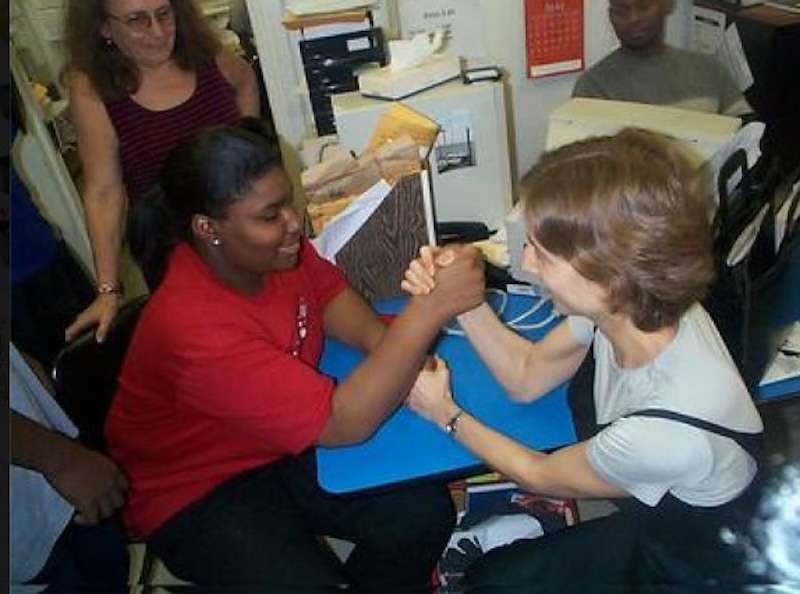
HarlemLIVE EIC Tameeka Mitchem and Playing 2 Win director, Mara Rose
A Perfect Partnership: HarlemLIVE Editor in Chief, Tameeka Mitchem, and Playing 2 Win Director, Mara Rose, engage in a friendly arm wrestling match
[/vc_column_text][/vc_column][/vc_row]
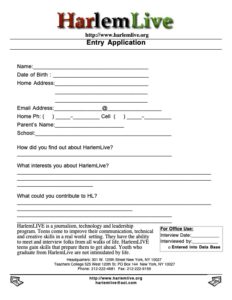 Starting the Journey: The HarlemLIVE Application Process
Starting the Journey: The HarlemLIVE Application Process
HarlemLIVE’s application process was the initial step for teenagers interested in journalism, technology, and leadership, serving as the gateway to this transformative program. Chapter 8 in the book, along with other parts of this blog, not only details how HarlemLIVE functioned but also serves as a blueprint for others looking to replicate similar programs.
Application Form Details :
- Personal Information: The form required basic personal details such as the applicant’s name, date of birth, home address, email address, and phone numbers. This was essential for maintaining a direct and personal connection with each applicant.
- Parental and School Information: It asked for the applicant’s parent’s name and the school they attended, ensuring a comprehensive understanding of the applicant’s background.
- Engagement Questions: The application inquired about how the applicant learned about HarlemLIVE, their specific interests in the program, and what contributions they felt they could make. These questions aimed to assess the applicant’s enthusiasm, motivation, and potential role within HarlemLIVE.
- Program Overview: The form also provided an overview of HarlemLIVE, emphasizing its focus on journalism, technology, and leadership skills in a real-world setting.
Unique Intake/Interview Process:
- A notable aspect of HarlemLIVE’s application process was that a veteran HarlemLIVE teen or alum usually conducted the intake and interview. This practice underscored the program’s commitment to being run by teens from the start, fostering a sense of ownership and peer-to-peer learning among participants.
Location and Contact Information (Historical):
- The application listed the headquarters of HarlemLIVE in New York, along with contact details including phone and fax numbers, and an email address.
Purpose and Legacy:
- The application process was a critical part of the HarlemLIVE journey. While the program operated from 1996 to 2010, its legacy continues to inspire and guide new initiatives. By documenting this process, the blog aims to provide a template for those wishing to establish similar programs, highlighting the importance of a well-structured application process in laying the foundation for a successful and impactful youth program in journalism and technology.
Through this historical overview and practical guide, readers can gain insights into the effective methods used by HarlemLIVE and apply these principles to develop their own youth-focused initiatives.
First Steps to Success: The HarlemLIVE Newbie Card
 At HarlemLIVE, embarking on the journey as a new member involved much more than just filling out an application form. It meant becoming part of a dynamic and passionate community, embracing its culture, and contributing to its vibrancy. To facilitate this integration, each newcomer received a “Newbie” card, acting as a comprehensive guide for their initial period in the program.
At HarlemLIVE, embarking on the journey as a new member involved much more than just filling out an application form. It meant becoming part of a dynamic and passionate community, embracing its culture, and contributing to its vibrancy. To facilitate this integration, each newcomer received a “Newbie” card, acting as a comprehensive guide for their initial period in the program.The Newbie card outlined a structured approach for the initial days, ensuring a smooth and inclusive start for every individual.
First Day:
- Familiarize yourself with cleaning areas.
- Take photos for staff page, press badge, and profile.
- Create a digital folder on the network and a physical folder.
- Write and keep an up-to-date profile.Create email and instant message account.
- Complete database and file application.
- Understand the stages, tutorials, staff data, and the HL CALENDAR.
Assessed by: [Name of the Assessor (HL Veteran or Alum generally)]
First Week:
- Ensure you have your Press badge.
- Begin learning touch typing.
- Determine your interests and set goals.
- Review guides created by editors, gather story and project ideas.
- Familiarize yourself with the checklist for going out on stories.
- Attend the Orientation Meeting (understand the story sheet and HarlemLIVE’s mission).
- Learn how to access the server from any computer.
- Understand the work areas.
- Learn phone etiquette for answering and making calls.
- Receive training for ‘man on the street’ interviews.
- Understand how to use the fax, printer, and copy machines (like loading paper and using fax covers).
- Learn scanning techniques.
- Add and access the Contacts database.
Assessed by: [Name of the Assessor]
First Month:
- Download digital photos and ensure cameras are put back to recharge.
- Resize images to make them web-ready.
- Create a resume.
- Participate in at least three stories in any capacity (reporter, photographer, videographer; gather background info, etc).
- Contribute at least one type of content to the site.
- Familiarize yourself with the process of virus checks or other tech necessities.
- Record receipts for petty cash purchases.
Assessed by:</strong id=”storyworkflow”> [Name of the Assessor]
The Story Ticket System at HarlemLIVE

Story Tickets were used to keep track of the stories. This evolved over time.
The “Story Ticket” utilized at HarlemLIVE was an instrumental tool designed to meticulously organize the entire lifecycle of a story, right from its conception to publication. Each Story Ticket served as a comprehensive repository, encapsulating vital information necessary for story development and eventual posting on the website.
Here is an expansion on the content elements of the Story Ticket:
I. Before the Event
- Contact/Event: Details of the event or person being covered by the story.
- Address: Location details of the event.
- Additional Sources: Any supplementary information or sources related to the story.
II. Staff Names / Roles
- Assigned Students and Advising Adults: Identification of the students and mentors involved in the story creation process.
III. Data Entry Information for Stories and Videos
- Data Entry Personnel: Individuals responsible for entering data related to the story or video.
- Section and Subsection: Classification of the story based on its thematic content, dividing it into various sections and subsections such as Arts and Culture, Community, Sports, etc.
Story Details
- Title: The title of the story.
- Publish Date: Planned publication date for the story.
- Description: A brief overview or summary of the story content.
- Author: Attribution to the person or persons responsible for creating the story.
- Caption: A concise caption accompanying the story (limited to 60 characters).
Procedure
- Procedure Steps: Detailed steps outlining the process to follow, including confirming schedules, conducting research, final preparations before going out for coverage, post-interview debrief, download, imaging edits, site posting, editing follow-ups, etc.
Attachments
- Paper Attachments: Optional physical documents related to the story, such as emails, fliers, or other print materials.
- Electronic Attachments: Full paths and filenames of electronic files associated with the story, including text files, images (thumbnails, larger thumbnails, and main images), flash files for videos, etc.
This detailed breakdown within the Story Ticket ensured that all necessary information, tasks, and resources required for the successful creation and publication of a story were methodically recorded and managed, contributing to an organized and efficient workflow for the HarlemLIVE team.
Our Organization System
We used a visible wall-mounted system of five ‘pockets’ to manage the progress of stories:
- Potential Stories: This folder contained initial ideas and upcoming events that were not yet assigned.
- Scheduled Stories: This held stories with arranged interviews and preliminary student assignments.
- Reported Stories / Stories in Editing Process: Here were stories that had completed reporting and were undergoing editing.
- Ready for Publication: Stories that were edited and finalized were kept here, ready for website upload.
- Stories to be Archived: Completed stories that were no longer current were moved here for record-keeping.

You can see some of the wall pockets we used to track progress of stories
Balancing Old and New: While we tried digital tracking systems, we found that a physical, hands-on method was sometimes more effective and easy to understand at a glance for both team members and visitors.
Personal Spaces: We also provided individual mailboxes for volunteers, giving them a personal space to keep their notes and documents organized.
This straightforward system allowed for effective tracking and management of stories, ensuring that each one moved smoothly through the process from idea to publication.

HarlemLIVE On-the-Go: The Essential Checklist
At HarlemLIVE, we believed in preparation. Before our reporters ventured out into the vibrant streets of Harlem or any other location, they were equipped with a checklist that ensured they were well-prepared.
When Going on a Story:
- Is Story Ticket (Sheet) Filled Out?
- Event Posted on HL online Calendar?
- Press Badges? (yours and others)
- HL Fliers
- Name of Org/Place/Event + Contact Person
- Information about …. (research)
- Address and Phone #s
- Cameras (check CHIPS and BATTERIES)
- Notepads and Pens
- Transportation Card and Sheet or Fare
- Tape Recorder (optional) / Walkie Talkies (*)
- Camera / Base / Tripod (optional)
- Batteries
- Headphones
- Microphone (wireless transmitters/receivers)
- Tapes – LABEL THEM!!
Returning from a story:
-
- Put pens, pads (take your notes out and put in your folder), badges and equipment away
- Debrief
- Download pics – LABEL CORRECTLY
- Type out notes / Write Reflections
- Recharge Batteries
- Put transportation card back
Empowerment Through Press Badges at HarlemLIVE
 At HarlemLIVE, the press badges were a vital tool for empowerment and learning, especially for newcomers. These badges, printed four to an 8½” x 11″ card stock, were laminated for durability and separated, each with a hole punched at the top for a chain or colored lanyard. When worn around the neck, they signaled a professional approach and intention.
At HarlemLIVE, the press badges were a vital tool for empowerment and learning, especially for newcomers. These badges, printed four to an 8½” x 11″ card stock, were laminated for durability and separated, each with a hole punched at the top for a chain or colored lanyard. When worn around the neck, they signaled a professional approach and intention.
These badges served as more than just identification; they were symbols of trust and credibility. They informed interviewees that conversations were intended for publication, backed by the First Amendment rights of the U.S. Constitution. This aspect was crucial in opening doors to new opportunities and experiences for the students.
 The badges granted access to spaces and individuals that might have been out of reach otherwise, playing a key role in the students’ journalistic empowerment. Through these badges, students interviewed influential figures and covered significant events, like celebrity appearances and critical community incidents, with newfound confidence and authority.
The badges granted access to spaces and individuals that might have been out of reach otherwise, playing a key role in the students’ journalistic empowerment. Through these badges, students interviewed influential figures and covered significant events, like celebrity appearances and critical community incidents, with newfound confidence and authority.
In essence, these press badges were not just pieces of plastic and lamination; they represented a transformation in the students’ lives, providing them with the tools and confidence to explore and report on their world.
The Heartbeat of Harlem: Pulse of the People

The hustle and bustle of Central Park became a regular backdrop for HarlemLIVE’s “Pulse of the People” (POP) interviews. More than just a reporting exercise, these street interviews became a transformative rite of passage for many of our students. From rookies learning the ropes to seasoned members guiding the way, the collaborative spirit of HarlemLIVE shone brightly during these excursions.
The First Taste of Journalism
Walking up to strangers and initiating conversations wasn’t everyone’s cup of tea, but it was an essential HarlemLIVE experience. With minimal training, we’d push our new members straight into the deep end. Yet, it wasn’t about throwing them under the bus; it was about teaching them to swim, to find their voice, and to shine.
Rite of Passage
The first POP interview was more than just an assignment; it was a transformative moment. The process was direct: “What news topics pique your interest?” After a newbie’s response, we’d transition to role-playing. How to initiate an interview, handle challenging respondents, and ensure the essence of the message was captured were all part of the drill. If the prospect of approaching strangers was too daunting for some, they’d start as photographers, capturing the essence of HarlemLIVE’s fieldwork through their lenses. HarlemLIVE was not just about journalism; it was about empowerment. It was about making sure each student knew their voice had value and teaching them to express themselves fearlessly. (See Creating Youth Journalists for more detailed instructions).
Student Voices: Growth and Transformation

Tameeka Mitchem reflects: “HarlemLIVE opened me up socially. … It made me more aware of my ability to go out and get the things I want.”

Ena with actress, activist, writer Ruby Dee
And Ena Johnson, who encountered HarlemLIVE as a novice high schooler, adds: “HarlemLIVE had a tremendous impact on my life outlook and journey to self-actualization… This built in me a confidence I carried into adulthood.”
In this video, witnessed Stanley Antoine finishing up his very first attempt at doing a person-on-the-street interview.
Staying Connected: Choosing the Right Digital Communication Platform
Student Autonomy and Responsibility at HarlemLIVE

Christina Camacho interviews a prospective student
Taking Charge from Start to Finish Students at HarlemLIVE were not just passive recipients of knowledge; they were at the forefront of story creation and execution. From initiating a story to scheduling interviews and conducting administrative tasks, students were entrusted with substantial responsibilities.
Practical Preparation for Real-world Encounters HarlemLIVE equipped its students with practical tools and techniques, preparing them for the journalistic world outside the classroom. The teaching approach, involving role-play and scripts, bolstered their confidence and competency, encouraging a robust learning environment.
Alumni Reflections on HarlemLIVE’s Impact
Aisha Al-Muslim: “At HarlemLIVE, the reins were in our hands. We managed everything – from writing and video production to maintaining the office. This autonomy cultivated a sense of responsibility and editorial discernment, empowering me in my subsequent professional pursuits.”
Ebony Myers: “HarlemLIVE was more than a place to learn; it was a space where I grew personally and professionally. The freedom to explore stories across the city, coupled with encouragement and support, paved the way for overcoming fears and embracing the world of journalism with confidence and curiosity.”
Empowering through Peer Teaching and Professional Guidance Peer teaching was a cornerstone of HarlemLIVE’s approach, fostering a community of learners who shared knowledge and experiences. Professional volunteers enriched the learning environment, bringing industry insights and expertise into the students’ realm.
HarlemLIVE’s approach to journalism education was a unique blend of autonomy, responsibility, and real-world preparedness. This empowered students to navigate the world of journalism with confidence, knowledge, and a sense of ownership.
HarlemLIVE’s Checklists: A Detailed Breakdown
 HarlemLIVE used detailed checklists to guide students through different learning areas such as journalism, photography, web design, tech, and administrative tasks. Here’s a closer look at how they worked:
HarlemLIVE used detailed checklists to guide students through different learning areas such as journalism, photography, web design, tech, and administrative tasks. Here’s a closer look at how they worked:
Purpose of the Checklists:
- Guidance: The checklists provided clear, step-by-step tasks, offering students a structured learning path.
- Autonomy: They allowed students to work at their own pace, promoting independence and self-guided learning.
Components of the Checklists:
- Specific Tasks: Each checklist contained specific tasks tailored to various learning areas, ensuring comprehensive coverage of necessary skills and knowledge.
- Peer Teaching: The checklists facilitated peer teaching, allowing experienced students to guide newer ones through different learning stages.
Professional Involvement:
- Industry Insights: Professionals from various fields volunteered to enhance the checklists with industry-standard knowledge and techniques, ensuring students received up-to-date and relevant training.
Usage:
- Versatility: Both new and experienced students used the checklists, ensuring everyone had access to a structured learning path.
- Flexibility: The checklists allowed students to manage their progress, ensuring that learning was self-paced and adaptable to each student’s needs.
In simple terms, the checklists were essential tools in HarlemLIVE’s educational approach, ensuring students had a clear, organized, and effective way to learn and develop their skills.
Empowering Voices: Public Speaking @ HarlemLIVE
At HarlemLIVE, we believed that the best person to tell a story is the one who lived it. Rooted in this belief, public speaking became an instrumental aspect of our educational arsenal. Inspired by real-life experiences and the foundational principles learned from esteemed platforms like the Dale Carnegie class, HarlemLIVE emboldened its youth to command stages, classrooms, and panels with authority and authenticity.
Navigating the Stage: A Journey from Inexperience to Expertise Our approach was simple yet transformative. After immersing themselves in various facets of our online magazine, our teens were equipped to stand before audiences, not just as speakers but as authorities in their fields. They didn’t just speak; they shared stories, experiences, and expertise that they had earned the right to talk about.
Beyond the Classroom: Taking Speech to Unconventional Platforms Our members were not limited to speaking within the familiar confines of HarlemLIVE or educational institutions. They ventured into diverse platforms, from high school classes within NYC’s Rikers Island prison to international stages in Vermont, sharing insights with audiences from Georgia, Pakistan, and beyond. These experiences weren’t mere speaking opportunities; they were chances to showcase resilience, knowledge, and the transformative power of the HarlemLIVE experience.
Stories of Transformation: In Their Own Words
Eddie, Shem, Katrina at Columbia Unviersity
Aisha Al-Muslim: “HarlemLIVE transformed my confidence. It was there that I learned the power of public speaking, sharing stories of our work and impact, which has become a crucial part of my career today.”
Treniese Ladson: “At HarlemLIVE, I found myself often in rooms full of people more educated, forcing me to overcome imposter syndrome. The confidence I built there wasn’t just about speaking; it was about asserting myself and reading the room, skills that have been indispensable in my career.”
Danya Steele: “HarlemLIVE wasn’t just a place to hone skills; it was a space that nurtured my confidence. Being one of the main public faces of HarlemLIVE, speaking on panels and conferences, allowed me to grow and navigate life’s complexities with a belief that ‘I can do this.’”
Kat Vorotova-Dey: “HarlemLIVE helped me overcome language barriers and fears, empowering me to approach public speaking with confidence. The practice I gained there propelled me in my career, ensuring that I never shied away from an opportunity to speak, share, and influence.”
HarlemLIVE’s Disruption: Redefining Youth’s Role in Public Speaking In the world outside HarlemLIVE, adults typically dominate the stage, especially when it comes to organizational representation. We flipped the script, placing our youth at the forefront. Their voices, charged with authenticity and passion, became our most potent narratives, illustrating HarlemLIVE’s impact and the immense capabilities of empowered youth.
Echoes Beyond HarlemLIVE: Long-lasting Impact on Careers and Lives The lessons learned and the confidence gained from speaking at HarlemLIVE didn’t just stay within our walls. They reverberated throughout the lives and careers of our members, equipping them with the ability to stand out in job interviews, dominate panel discussions, and shine on various platforms long after their HarlemLIVE journey.
In every speech, every presentation, HarlemLIVE’s speakers carried more than just words; they carried the embodiment of a transformative experience, proving that when the youth speak, the world doesn’t just listen; it stands in awe and applause.
Diverse Exposures: The Real Classroom of HarlemLIVE
 HarlemLIVE’s unique approach to education was about tossing the traditional classroom setting out the window and pushing students into the vast, vibrant, and unpredictable classroom of real-world experiences. Stationed in the media capital of the world, New York City, HarlemLIVE leveraged its location to expose students to a kaleidoscope of people, professions, and platforms. Students didn’t just learn journalism; they lived it, engaging with a diverse array of personalities from presidents to pop stars.
HarlemLIVE’s unique approach to education was about tossing the traditional classroom setting out the window and pushing students into the vast, vibrant, and unpredictable classroom of real-world experiences. Stationed in the media capital of the world, New York City, HarlemLIVE leveraged its location to expose students to a kaleidoscope of people, professions, and platforms. Students didn’t just learn journalism; they lived it, engaging with a diverse array of personalities from presidents to pop stars.
Danya Steele: “HarlemLIVE was more than an office; it was an arena of action. The encouragement to ‘Get out, be in action, use your youth,’ pushed us beyond conventional boundaries, turning the entire city into a dynamic learning space. It was a culture of curiosity and exploration, where our press badges were passports to opportunities and real-world learning.”
Johnny Alarcón: “HarlemLIVE urged us out of our comfort zones. Guided by a spirit of adventure and a buddy system, we navigated the streets, learning not just to report but to connect, engage, and empathize. It was about cultivating skills, courage, and kindness in the vibrant and varied classrooms of New York City.”
This approach not just enriched their journalistic skills but broadened their horizons, allowing them to glean knowledge, experience, and stories from the colorful and diverse tapestry of the city’s life. Students found themselves navigating new environments, from the glamour of award shows to the gritty streets, engaging with a spectrum that spanned from Hillary Clinton to Jay Z.
 The essence of HarlemLIVE’s teaching philosophy was not about telling tales but living them first, ensuring each student had a rich reservoir of experiences and stories to share, making learning not just informative but profoundly transformative.
The essence of HarlemLIVE’s teaching philosophy was not about telling tales but living them first, ensuring each student had a rich reservoir of experiences and stories to share, making learning not just informative but profoundly transformative.


A Visionary Project: The Clickable Map of Harlem
HarlemLIVE embarked on an extraordinary project: creating an interactive, comprehensive map of Harlem. Before Google Maps became a ubiquitous tool, our young team set out on a mission—document every block of Harlem, capturing the essence of neighborhoods, streets, and communities through photographs and descriptions.
 The ‘Clickable Map of Harlem’ not only fostered technical skills in photography and digital mapping among the youth but also ignited curiosity and engagement within the Harlem community. People began to recognize the HarlemLIVE team, approaching them with interest and inquiries about the project. It was a unique blend of technology and community involvement, allowing students to explore and connect more deeply with the neighborhoods they were documenting.
The ‘Clickable Map of Harlem’ not only fostered technical skills in photography and digital mapping among the youth but also ignited curiosity and engagement within the Harlem community. People began to recognize the HarlemLIVE team, approaching them with interest and inquiries about the project. It was a unique blend of technology and community involvement, allowing students to explore and connect more deeply with the neighborhoods they were documenting.
Despite facing challenges, such as the evolving technological landscape and the obsolescence of the Flash platform, the project symbolized more than a digital achievement. It was about process, learning, and the growth that came from attempting something innovative and challenging.
HarlemLIVE’s project left a powerful imprint, epitomizing a commitment to community, technology, and the educational growth of our youth, ensuring they were equipped, inspired, and ready to make meaningful contributions to the technological world.
HarlemLIVE wasn’t just about teaching journalism; it was a platform where young voices flourished. The youth learned more than just technical skills—they discovered the influence and reach of their own voices. The experience at HarlemLIVE didn’t just stay with them as a memory but actively shaped their futures and career trajectories.
DISCUSSION TOPICS:
Why is it important for students to engage in authentic experiences in their education?
- Real-World Application: By engaging in authentic experiences, students not only learn theoretical knowledge but also understand how it applies to real-world situations. They can better see the relevance and value of what they’re learning.
- Development of Critical Skills: Facing genuine challenges helps youth develop essential life skills, such as problem-solving, communication, adaptability, and perseverance. It’s one thing to talk about a skill; it’s another to put it into practice.
- Boosting Confidence: By succeeding in real situations (or learning from failures), youth gain confidence in their abilities. They learn they can handle challenges and that they have valuable contributions to make.
- Fostering Independence: Authentic experiences encourage students to think for themselves, make decisions, and take ownership of their actions. This nurtures independence and a sense of agency.
- Resilience Building: Facing real challenges and, at times, experiencing real failures, helps youth build resilience. They learn that setbacks are a part of life and can be overcome.
- Preparation for the Future: The real world won’t shield them from challenges. By facing genuine experiences now, they’re better prepared for future challenges in work and life.
- Deep Learning: Authentic experiences often lead to deeper learning and understanding. Instead of surface-level memorization, students engage with concepts at a much more profound and personal level.
Empowering Youth: Insights and Lessons from HarlemLIVE’s Approach
In chapter 8, there was mention of how some adults felt they should make the initial phone calls ahead of the students who were to set up the interviews. This was totally antithetical to the mission of HarlemLIVE.
The perspective of wanting adults to make initial contact before youth reach out for interviews likely stems from a combination of protective instincts, perceptions about professionalism, and potential underestimations of youth capability. Here are some reasons adults might have felt this way:
Protective Instincts: Adults often have an instinctual desire to shield young people from potential harm, disappointment, or rejection. By making the initial call themselves, they might believe they are creating a smoother path for the youth, ensuring they don’t face any rudeness or dismissals.
Perceived Professionalism: Some adults may believe that a call coming from another adult, especially one associated with the program, would be taken more seriously or be seen as more professional by the potential interviewee. This perspective assumes that adults will be more successful in setting the stage for the interview.
Underestimation of Youth Capability: There’s often an implicit bias where adults may underestimate the capabilities of young people. They might think that youth aren’t mature, skilled, or persuasive enough to secure an interview on their own, even though, with proper training and scripts, many youth can handle these tasks quite adeptly.
Fear of Negative Reflection on the Program: There might be concerns that if a young person doesn’t handle the call “perfectly,” it could reflect poorly on the entire program. By having an adult make the initial call, they may believe they are ensuring the program is always presented in the best light.
Concerns about Misunderstandings or Miscommunications: Adults might worry that youth won’t communicate all the necessary details accurately or might miss out on capturing essential information, leading to confusion or misunderstandings.
Cultural or Societal Norms: In some cultures or societal structures, it’s customary for elders or those in perceived positions of authority to initiate communications or establish relationships. It might be seen as a sign of respect or propriety.
While these reasons might explain why some adults feel the way they do, it’s crucial, especially in a program like HarlemLIVE that aims to empower youth, to trust young people with responsibilities and let them navigate real-world experiences. The learning that comes from such direct interactions is invaluable and can’t be replicated by shielding or doing tasks on their behalf.
For anyone seeking to understand or replicate a successful youth engagement model, chapter 8 provides invaluable insights. Here are some key takeaways:
Structured Autonomy: HarlemLIVE demonstrated the importance of balancing structure with autonomy. The use of story tickets, training checklists, and newbie cards provided guidance while still granting students significant independence.
Empowerment Through Responsibility: We make a compelling case for entrusting youth with responsibility. This not only made them invested stakeholders but also rapidly accelerated their learning and growth.
Diverse Exposure: The myriad experiences, from interviewing prominent personalities to documenting every block of Harlem, underlined the significance of exposing youth to diverse situations to broaden their horizons.
Peer Teaching & Mentorship: HarlemLIVE’s model emphasized the value of peer teaching and mentorship, showcasing how the absence of a hierarchical structure can still result in effective learning.
Value of Authentic Experience: The program’s real-world approach to journalism and media meant students faced genuine challenges and learned from them.
Incorporating Technology: The focus on modern tools, from Apple computers to early online chat platforms, underscored the importance of integrating technology into educational and engagement models.
Evolution & Adaptability: The program’s readiness to evolve, whether it was adapting to new technological platforms or adjusting strategies based on challenges, highlighted the importance of being nimble and adaptive.
Listening to Youth Voices: The numerous testimonials emphasized the importance of truly listening to young people, understanding their perspectives, and valuing their contributions.
Real-world Preparedness: HarlemLIVE’s approach was geared not just towards immediate tasks but towards preparing students for the real world, from public speaking to networking.
For educators, youth program organizers, community leaders, and anyone passionate about youth empowerment, this chapter offers a goldmine of practical insights, strategies, and anecdotes that can inform and inspire.

 Key Considerations for Choosing a Platform:
Key Considerations for Choosing a Platform: